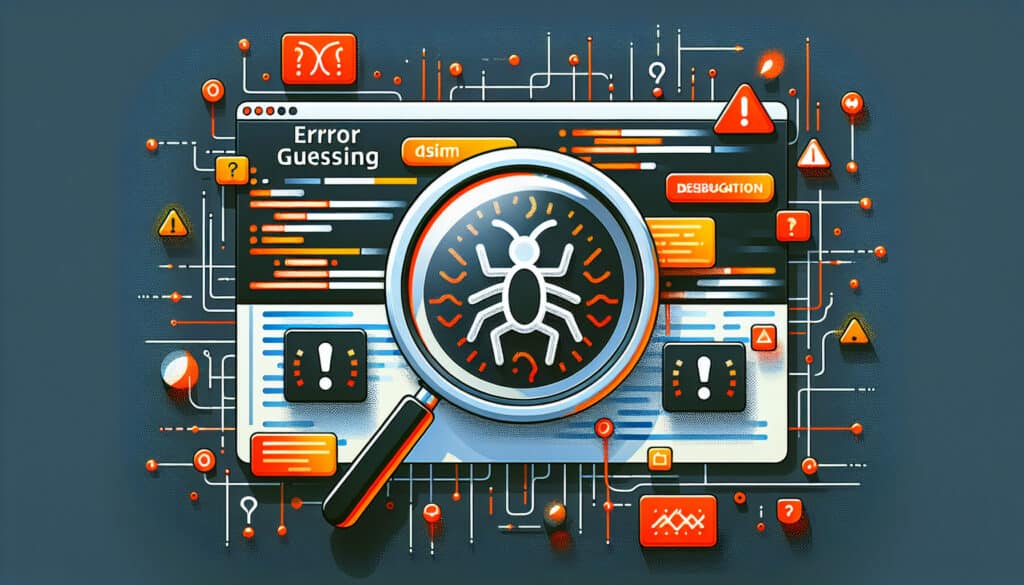To identify defects in software by anticipating errors that are likely to occur.
- Metodologías: Ergonomía
Adivinar errores

Adivinar errores
- Metodología ágil, Mejora continua, Seguro de calidad, Control de calidad, Gestión de riesgos, Pruebas de software, Métodos de ensayo, Pruebas de usuario, Validación
Objetivo:
Cómo se utiliza:
- An experience-based testing technique where the tester uses their intuition, experience, and knowledge of the system to guess where errors might be. It is often used to supplement more formal testing techniques.
Ventajas
- Can find defects that other techniques might miss; Does not require formal test case design.
Contras
- Highly dependent on the skill and experience of the tester; Not a systematic or repeatable method.
Categorías:
- Calidad, Gestión de riesgos
Ideal para:
- Supplementing formal testing techniques to find defects in complex or error-prone areas of a software application.
Error Guessing is particularly effective in industries where software applications demand high reliability and user satisfaction, such as finance, healthcare, and aerospace. Testers with extensive experience in these fields often initiate Error Guessing during the testing phases, especially when prior incidents or user feedback have indicated vulnerable areas. This method shines in exploratory testing sessions, where knowledge of the application’s architecture or past bugs can guide testers to focus on high-risk components that formal testing might overlook. It also encourages collaboration among team members, as discussions can arise about potential fail points based on diverse experiences and insights. In agile environments, where quick iterations are commonplace, Error Guessing can complement automated testing frameworks by targeting areas not sufficiently covered by scripted tests. Participants in this process typically include senior testers or developers who possess deep domain knowledge, ensuring that their intuition aligns with real-world usage scenarios. Moreover, applying this technique during regression testing phases can reveal defects introduced by new changes, thus enhancing product stability as updates are implemented. This method stands out due to its flexibility and adaptability, making it a valuable addition in diverse contexts, particularly where the stakes of failure are significantly high.
Pasos clave de esta metodología
- Identify high-risk areas based on system knowledge and complexity.
- Use intuition to hypothesize potential failure points in the application.
- Design exploratory tests around the guessed areas of failure.
- Execute the tests while varying conditions and parameters to uncover defects.
- Adjust testing focus based on findings and intuition during the process.
- Repeat the guessing and testing cycle for continuously evolving areas.
- Collaborate with domain experts to refine understanding of potential issues.
Consejos profesionales
- Utilize experience from previous projects to identify patterns of failure, focusing on areas where similar systems have struggled.
- Engage in exploratory testing sessions with diverse team members to blend different perspectives on potential weak points in the application.
- Keep a comprehensive log of past errors encountered and use this data to guide future guessing in areas of likelihood and severity.
Leer y comparar varias metodologías, recomendamos el
> Amplio repositorio de metodologías <
junto con otras más de 400 metodologías.
Sus comentarios sobre esta metodología o información adicional son bienvenidos en la dirección sección de comentarios ↓ , así como cualquier idea o enlace relacionado con la ingeniería.
Contexto histórico
1828
1850
1854
1854
1911
1928
1950
1827
1848
1850
1854
1895
1914
1943
1970
(si se desconoce la fecha o no es relevante, por ejemplo "mecánica de fluidos", se ofrece una estimación redondeada de su notable aparición)















Publicaciones relacionadas
Calculadora de METS a calorías
Metaanálisis
Asignación de mensajes
Diagramas de modelos mentales
Fuerzas de empuje y tracción máximas admisibles
Planificación de necesidades de material (MRP)